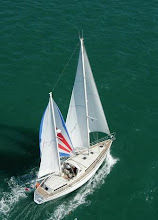We left Virgin Gorda early afternoon on the 9th of April. We intended sailing to Saint Martin, but the persistent east wind brought us to Saba.Sailing through the night, we arrived there at a daybreak and Saba appeared as a mysterious dark rock rising from the sea.
A light high up on the hill was the sign of life, and then the first morning sun rays outlined a few daring little white houses clenching on to the cliffs.
 |
| Mooring area |
 |
| 800 steps carved into the rock lead to the Ladder Bay |
We hung on to the mooring for two days before the seas calmed enough for us to place the motor onto the dinghy. We were determined to visit Saba this time. We moored by the Saba before for a few hours to be rested for an overnight sail to Puerto Rico.
We took a tour with a nice guide and a good driver Cornelius. The road was carved into the rock, some places it felt as if we were hanging over a sea far below us.
 |
| Cornelius and Polde |
Saba looks rocky from a distance, but it is a green island, especially on the 3000 ft top, almost always hugged by the cloud.
On the five square miles only two main villages are spread over the mountains' saddles. The houses are neat, white with red roofs, well maintained and enchanted with gardens.
1500 Sabans are descendants of Dutch, Scottish and English settlers, and some Africans, who originally came to the island as slaves. They have a strong sense of community and are well organized. Schools, daycare, a home for elderly and handicapped, they have it all. Saba is clean, touring it we saw gloved teenagers with trash bags picking up whatever the wind swirled into the bushes. Cornelius told us that keeping Saba clean is the duty of the school children.
There are also 400 medical students from all over the world living on Saba. It is not unusual for a Caribbean island to have a medical school. Quiet a few do.
Saba doesn't have beaches, tourists are mostly divers and sailors like us, passing by once a year.
There is a lot to see besides the spectacular views, visiting their galleries and shops with local crafts is a special treat. Lacework brought here centuries ago from the Venezuela, became Saba's tradition.
 |
| Learned the lacework from her ancestors, a Saban woman continues the tradition while being a museum caretaker |
A walk through the town called Bottom:
 |




















No comments:
Post a Comment